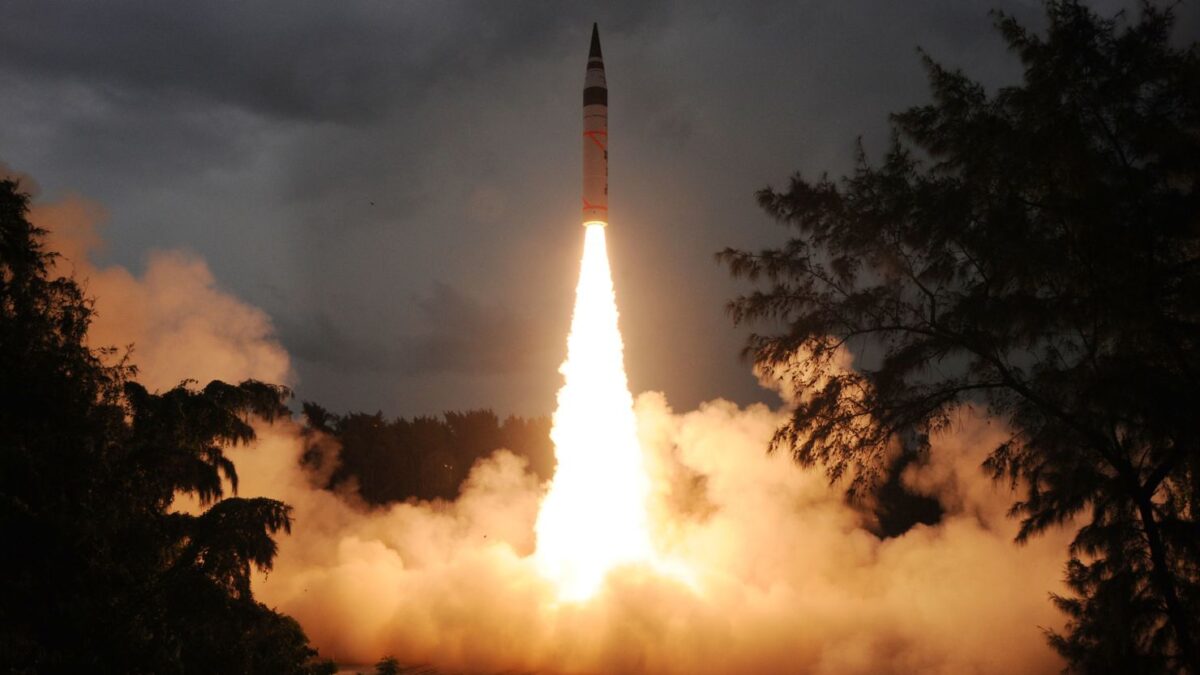- The “Divyastra” test of the Agni-5 ballistic missile, carried out by the Defence Research and Development Organisation (DRDO), is strategically significant.
Context:
- The Agni-5 missile has a range of more than 5,000 kilometres, making it the longest-range missile tested by India. However, it is not just its range, but also its lethality, that marks a watershed moment in India’s nuclear deterrent.
- This variant strengthens India’s nuclear deterrent by including Multiple Independently Targetable Re-entry Vehicles (MIRVs).
What is a MIRV?
- MIRVs- A MIRV is a’missile bus’ loaded with nuclear weapons that can be delivered to multiple targets using a single rocket. This means that MIRV can use a single missile to target many targets that may be hundreds of km apart.
Background:
- In 1970, the US deployed the Minuteman III, the first MIRV-ed ICBM with three warheads. In 1971, it deployed the Poseidon, the first MIRV-ed submarine-launched ballistic missile (SLBM), capable of carrying up to ten warheads on each missile.
- Following the lead of the United States, the Soviet Union developed its own MIRV-ed ICBM and SLBM technologies in the 1970s.
- China has developed and deployed MIRV technology, with multiple warheads installed on its DF-5B ICBMs.
- France and the United Kingdom are known to possess MIRV-equipped missiles.
Why MIRV technology is so lethal?
- Unlike conventional missiles, which deploy a single warhead, MIRV-equipped missiles can launch numerous warheads at varied speeds and trajectories.
In comparison to China:
- India’s late entry: While MIRV technology is not new in the world, India’s development of MIRV-capable ballistic missiles places it within a narrow group of nations that have such capabilities, including established nuclear powers such as the United States, Russia, China, France, and the United Kingdom.
- MIRV-tipped missiles have the potential to limit damage because they can strike many targets at the same time and evade ballistic missile defences. China’s developments in ballistic missile defences, such as the HQ-19 interceptors, offer a challenge, though their efficacy against India’s Agni series missiles, particularly the Agni-5, requires further improvement.
- Further Testing: While incorporating MIRV technology into the Agni-5 is a big step forward, additional testing and refinement will be required to improve the credibility and effectiveness of India’s nuclear ballistic missile arsenal. The Indian armed forces are anticipated to conduct several tests to guarantee reliability and readiness.
The challenges to the development of MIRV-capable ballistic missiles include:
- Nuclear Warhead Miniaturisation: Miniaturising nuclear warheads is a difficult technical challenge for MIRV-capable missiles. Inadequate nuclear testing by India has limited the extent to which warheads can be miniaturised for MIRV uses.
- Receptacle Weight Reduction: Before being released from the Post Boost Vehicle (PBV), the receptacle containing the warhead or re-entry vehicle must be light in weight or mass. This need complicates the design and engineering of the missile system.
- Precision Configuration: Re-entry vehicles must be properly configured to fit into the missile while remaining distinct from the PBV, which must be manoeuvrable. This demands rigorous design and testing to ensure optimal functionality.
- Guidance and precision are critical for MIRV-capable missiles because re-entry vehicles must be spin-stabilized during atmospheric reentry. Achieving the requisite level of precision complicates the development process.
- Geographic limitation: MIRV-based missiles can only attack numerous targets within their geographic footprint. This constraint necessitates careful strategic planning and implementation.
- Limited Nuclear Testing: India’s limited nuclear testing history has hindered the ability to miniaturise warheads and develop MIRV technology. The absence of testing has caused issues for Indian missile and nuclear developers.
- Integration Difficulties: Integrating warheads with missiles is a difficult procedure that necessitates cooperation across multiple entities, including the Terminal Ballistics Research Laboratory (TBRL) and Advanced Systems Limited (ASL). Overcoming integration problems increases the difficulty of MIRV development.
- Decoys and countermeasures: The Agni-5 missile’s ability to carry decoys and chaff remains uncertain, particularly during the boost and intermediate phases of flight. Integrating countermeasures introduces new technical hurdles.
- Agni-5 is anticipated to launch from a road-mobile platform, which raises logistical and operational concerns for deployment.
Future Scope of Indian Projects:
- Submarine Launched Ballistic Missile (SLBM) Testing: India plans to test a long-range SLBM that will be launched from its nuclear ballistic missile submarines. This initiative attempts to strengthen India’s nuclear deterrence capabilities by including a sea-based component into its arsenal.
- Continued Development by DRDO and AEC: The Defence Research and Development Organisation (DRDO) and India’s Atomic Energy Commission (AEC) are likely to continue working together to develop advanced missile and nuclear technology. This agreement demonstrates India’s commitment to enhancing its defence capabilities.
- Strategic Focus on China: The Agni-5 with MIRV capability was developed particularly to address possible threats from China’s missile and missile defence programmes. India’s strategic focus remains on maintaining a credible deterrent against China.
- Enhanced nuclear capabilities: The successful test of the Agni-5 MIRV missile is a big step forward in India’s drive to become a highly credible nuclear and missile force. It demonstrates India’s willingness to strengthen its nuclear capabilities in order to adequately respond to rising threats.
Conclusion:
Despite challenges, India’s MIRV breakthroughs strengthen nuclear deterrence against China. Continued testing and SLBM development demonstrate India’s commitment to improving defence capabilities and maintaining regional stability.
Source: https://www.orfonline.org/research/the-mirv-leap-that-fires-up-india-s-nuclear-deterrence#:~:text=The%20Agni%2D5%20with%20MIRV,missile%20and%20missile%20defence%20programmes.

